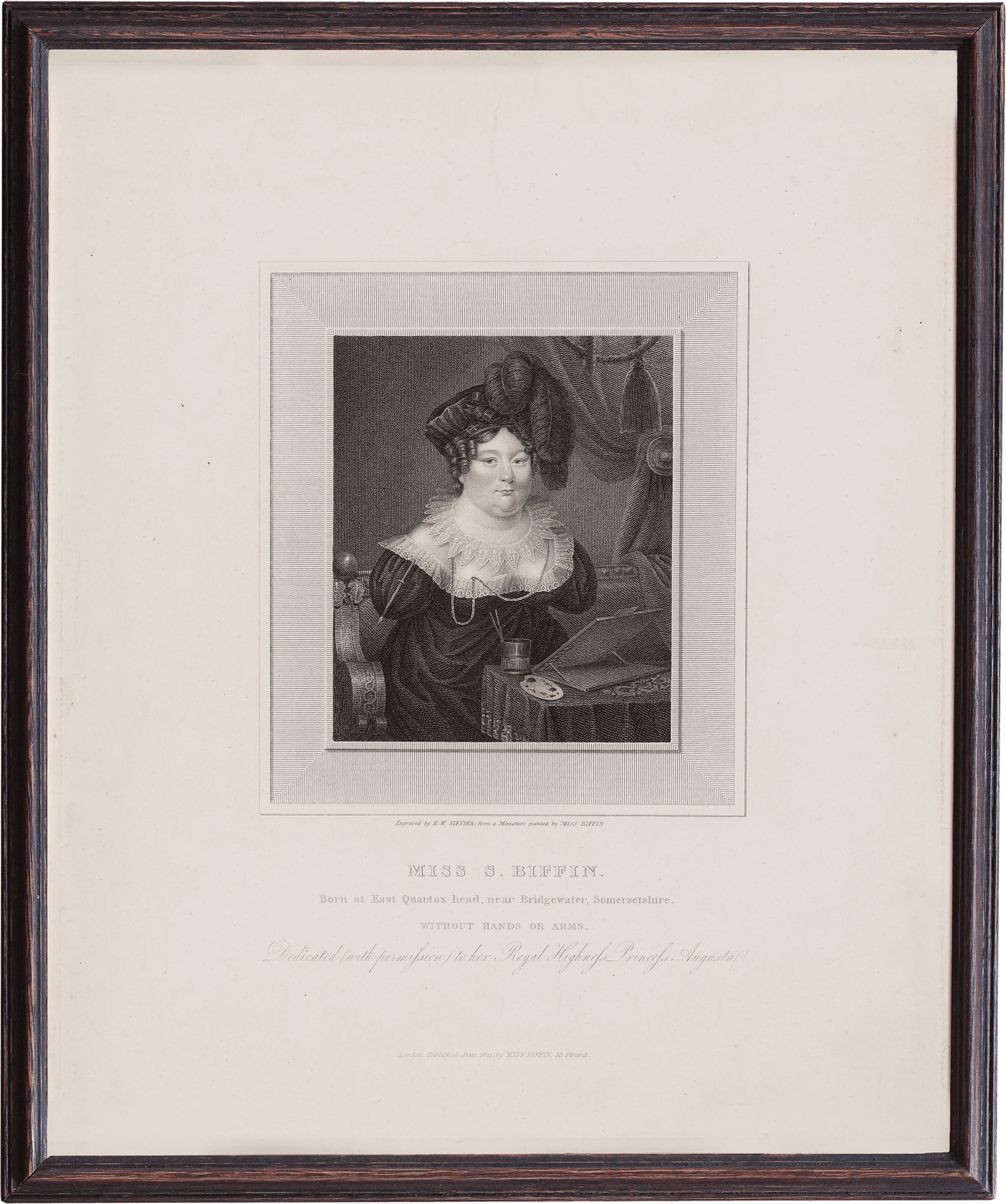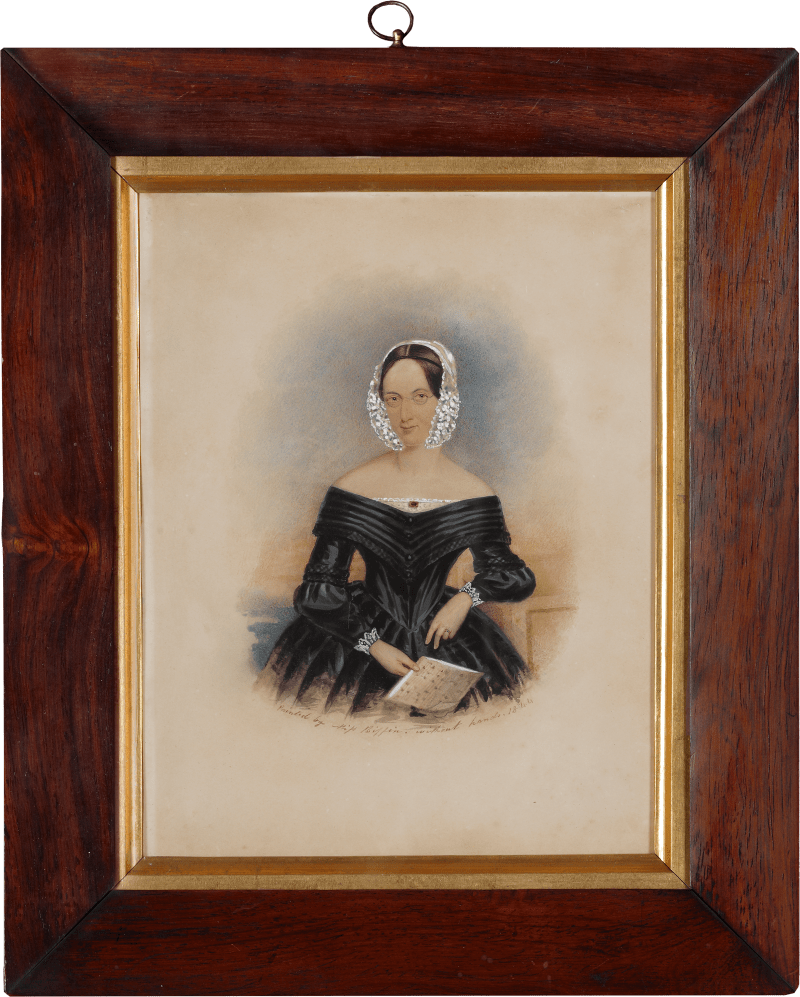‘I [...] have been flattered into an expectation, that a Print of MYSELF, from a Painting of MY OWN, would, under all circumstances of my case, meet with encouragement from a liberal Public.’[1]
— Sarah Biffin, 1821
This engraving is taken after Sarah Biffin’s 1821 self-portrait, which recently sold at auction for £137,500.00 [fig. 1]. The portrait exemplifies Biffin’s triumphant rise to fame at this date; in 1821 Biffin acquired a studio in London and submitted work to the annual exhibition at the Royal Academy of Arts; she received a silver medal from The Royal Society of Arts (announced by Prince Augustus Frederick, who proclaimed that her work deserved the greatest honour); and later that year she travelled abroad to Brussels where she became miniature painter to Willem Frederik, Prince of Orange and future king of the Netherlands.
Biffin’s upbringing was less artistic; she was born into a farming family in Somerset in 1784. Her baptism records show that...
‘I [...] have been flattered into an expectation, that a Print of MYSELF, from a Painting of MY OWN, would, under all circumstances of my case, meet with encouragement from a liberal Public.’[1]
— Sarah Biffin, 1821
This engraving is taken after Sarah Biffin’s 1821 self-portrait, which recently sold at auction for £137,500.00 [fig. 1]. The portrait exemplifies Biffin’s triumphant rise to fame at this date; in 1821 Biffin acquired a studio in London and submitted work to the annual exhibition at the Royal Academy of Arts; she received a silver medal from The Royal Society of Arts (announced by Prince Augustus Frederick, who proclaimed that her work deserved the greatest honour); and later that year she travelled abroad to Brussels where she became miniature painter to Willem Frederik, Prince of Orange and future king of the Netherlands.
Biffin’s upbringing was less artistic; she was born into a farming family in Somerset in 1784. Her baptism records show that she was ‘born without arms and legs’. Teaching herself to write and draw from a young age, Biffin rose to fame as an artist and established a professional career as a portrait painter. Throughout her long and successful career, she travelled extensively, visiting almost every ‘principle town’ across Great Britain (as many of her advertisements proudly boast). She painted for nobility and royalty and recorded her own likeness through exquisitely detailed self-portraits. This engraving was taken at the height of her artistic powers.
This lithograph – dedicated ‘By Permission to H.R.H the Princess Augusta’ – was printed soon after Biffin published a short biography. With details of her life and pictures of her work, she circulated An Interesting Narrative and Proposals for a Print of Miss Biffin amongst her wealthy clientele, likely with the help of Morton. She openly revealed that:
‘The object is to raise a sum to enable me to make a purchase of some real property, which would afford me a certain income when my immediate means of support are diminished…’[2]
This candid objective places Biffin at the forefront of women’s independence at a time when self-promotion was perceived as profoundly unfeminine, and property ownership was unusual for women.
While embodying artistic success, Biffin’s original 1821 self-portrait also establishes her status as a professional artist. She depicts herself in her studio, surrounded by symbols of her achievement, including what appear to be commissioned portrait miniatures in the background. The portrait also offers valuable insight into her painting technique. Her paintbrush is fastened to a loop, sewn onto the right shoulder of her dress whilst her painting slope is turned to face her. Biffin places the viewer in her studio and, with an expression of calm anticipation, aligns her observer with the perspective of someone sitting for a portrait.
Biffin’s self-portraits offer invaluable insight into how the artist viewed herself, and how she wished to be viewed by others. She recorded her likeness continuously throughout her career, always presenting herself as an artist dressed at the height of fashion. Whether for private consideration or public presentation, she rarely concealed her disability: but neither did she make it highly conspicuous. She placed more importance on her fame as an artist, as indicated by the recurrent inclusion of her paintbrush. All her life, Biffin’s appearance had been scrutinised by others. She was cast in popular culture as a phenomenon, and her disability was remarked upon by contemporaries, including callous comments by the likes of Charles Dickens. Through her self-portraits, she was able to take control of and determine the image she wished to present; that of an accomplished and confident artist.
[1] Sarah Biffin, ‘An Interesting Narrative and proposals for a print of Miss Beffin to be dedicated, by permission to H.R.H the Princess Augusta’, 942 BIF/10, Liverpool Record Office, Liverpool.
[2] Sarah Biffin, ‘An Interesting Narrative and proposals for a print of Miss Beffin to be dedicated, by permission to H.R.H the Princess Augusta’, 942 BIF/10, Liverpool Record Office, Liverpool.













